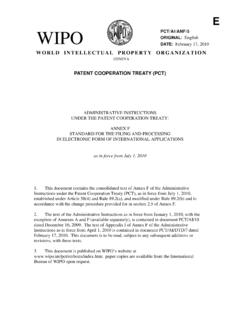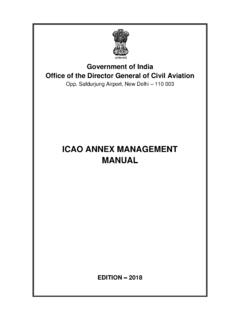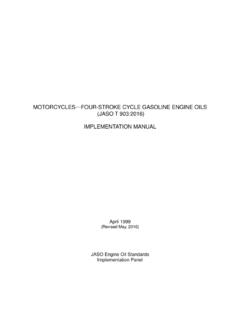Transcription of Basic Principles of the Common Application …
1 Basic Principles of the Common Application format Prepared by the Trilateral Offices 30 November 2007 - 2 - Basic Principles of the Common Application format Prepared by the Technical Working Group on Formal Aspects of Patent applications I. Background At the November 2005 Trilateral Pre-Conference, the Trilateral Offices established a Technical Working Group on the Formal Aspects of Patent applications in response to a request made by the Industry Trilateral that the Trilateral Offices begin working on the standardization of formal aspects of patent applications .
2 The Trilateral Offices have come to an understanding with respect to a Common format for patent applications in response to the request from users, after having intensive discussions at six Working Group meetings from 2006 to 2007. The Common Application format developed by this Trilateral Working Group with the participation of the World Intellectual Property Organization is in support of a Trilateral goal of a global standardized Application format which would allow applicants to prepare a single Application that could be accepted by each participating office without the need for further changes to comply with formal requirements.
3 The project furthers the principle of the Patent Law Treaty using PCT standards when applicable. It takes into consideration the preparations for the implementation of the PLT and the further adoption of XML processing. II. Mandate for the Technical Working Group on the Formal Aspects of Patent applications (Annex 1 of the Report of the 23rd Trilateral Pre-Conference and as amended at the 24th Trilateral Pre-Conference, further amended at the Strategic Working Group in September 2007) The Technical Working Group shall formulate recommendations for addressing the following issues: 1.
4 Standardization of patent applications , with a view to maximizing compatibility with the requirements of the PLT, PCT, and Trilateral Offices; 2. Standardization of the patent Application format , taking into consideration the promotion of electronic filing and processing; such that an Application drafted in conformance with the Common Application format will be acceptable in any of the Trilateral offices without further modification. It is the understanding of the Technical Working Group that the results of this project will be provided to the XML Technical Working Group for consideration of amendments to WIPO Standard - 3 - In formulating these recommendations, the Technical Working Group should work on them concurrently and attempt to identify issues that can be dealt with rapidly at a practical level, drawing on current practices and formats and taking into consideration the potential impact on the offices and the viewpoints of the relevant stakeholders.
5 The Technical Working Group shall be comprised of representatives from each of the Trilateral Offices and the WIPO. III. Basic Principles 1. The objective of the Common Application format is to provide a basis for filing applications that is beneficial to both applicants and participating offices. 2. Although the use of the Common Application format by applicants is optional, any filing claiming to be in the Common Application format must implement all of the requirements. 3. The Common Application format will be based on the best practices applied to the existing PCT format and is aimed at addressing remaining differences in national/regional law and practices.
6 4. The Common Application format will be applicable eventually to all forms of patent submissions and it is a long term goal of the Trilateral Offices to accept applications in text-based XML. 5. The Common Application format will ensure that applications will meet the formal requirements of the Trilateral Offices. 6. The Common Application format will be progressively applied to each kind of Application filed with each office. 7. Comments from Industry Trilateral are taken into account in the Common Application format . 8. An Application which complies with the Common Application format shall be accepted without any further amendment by any of the Trilateral Offices as a national/regional Application as far as the agreed-upon formal requirements are concerned.
7 Each of the Trilateral Offices may provide requirements which are more favorable for applicants than the requirements provided for by the Common Application format . 9. After some experience, the Trilateral Offices will consider whether it is necessary to amend the PCT. IV. The Common Application format The Common Application format is described in Annex I. The comparative table of examples for each type of the applications is shown in Annex II. - 4 - 1. Permissibility of Delimiter An Application filed on paper or in PDF format tagged with a specific delimiter (for example, Sumitsuki bracket or curly bracket {} ) for the headings including section titles, paragraph numbers, and signs of numbering as defined in Annex I ( , Fig.)
8 1 , Table 1 ) shall be accepted by all the Trilateral Offices. 2. XML e-filing Electronically filed applications with XML tags are accommodated in the Common Application format . That is to say, WIPO Standard & Annex F to the PCT Administrative Instructions shall be updated to correspond to Common Application format headings. V. Pilot Project The user group participants of the 4th Working Group and the Trilateral Offices implemented the pilot project from April to August 2007, according to the steps described in Annex II and III to the report of the 4th session of the Working Group.
9 In the pilot project, the user group participants prepared hypothetical applications in the Common Application format . The Trilateral Offices confirmed whether the submitted hypothetical applications complied with all the requirements of the agreed-upon Common Application format and whether they are acceptable to each of the Trilateral Offices. As a result of the pilot project, the main indication among those submitted by the user group participants and the Trilateral Offices is as follows: Common Issues Placement of section titles, paragraph numbers and claim numbers, etc.
10 Use of bold, italics and underlining in the Application , especially in section titles Insertion of "the" into section titles, , "Title of the Invention" Issues for Tagging Benefit of tagging to Non-XML applications as compared to the costs incurred Difficulty for an XML converter to automatically distinguish the curly brackets used in the pilot project as tags from the curly brackets used in mathematical expressions or the like Need to develop tools to make tagging and translation easy and accurate Evaluation by the Trilateral Offices The Evaluation of the pilot project by the Trilateral Offices is as follows.







